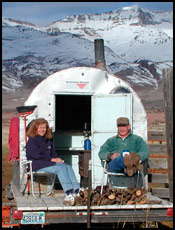
Ron Torell with his wife, Jackie.
Cow Camp Chatter
Strategic Weaning: Managing cow body condition during drought.
Many regions of the country are experiencing one of the driest precipitation cycles in recent history. These extreme drought conditions require management intervention on behalf of the bovine. Some ranchers are turning their cows out on irrigated pasture with no plans of haying their meadows. Others are reducing the size of their herds through stringent culling and marketing.
Cattlemen are faced with making critical management decisions. They need to either increase nutrient supply, which is costly, or decrease nutrient demand. During periods of drought, strategic weaning is one management option ranchers can use to reduce nutrient demand in an effort to manage cow body condition relative to the available nutrient supply.
Management for cows
Reduced quantity and quality of feed during drought years coupled with the effects of suckling and lactation generally result in thin cows. Thin cows are set up to fail reproductively unless steps are taken to turn this around. The short-term effect of suckling and lactation during drought conditions lengthens a cow's postpartum interval. This may reduce or delay pregnancy during her current breeding season. Long-term effects may delay or reduce pregnancy in subsequent years.
There is little basis
for the practice of
205-day weaning in
commercial herds.Forage resources vary greatly in different regions of the country and are contingent upon annual precipitation. In areas and years when feed conditions are favorable, some cows and calves may actually gain weight late in lactation. Under these conditions, an extended lactation or delayed weaning date may be warranted. However, if low reproductive rates and low body condition scores are anticipated due to drought conditions, altering weaning dates is one option to be considered to add body condition to thin cows.
Weaning calves from mature cows at 5 to 6 months of age has the potential to increase cow body condition by reducing forage and nutrient demands. The most favorable months to change body condition in late-spring-calving cows are generally September, October and November.
Prior to September, and/or a calf age of 150 days, the production/demand for milk is high, making it difficult to add cow body condition. After November, expensive processed feeds may be required because standing dry forage oftentimes is in short supply and of inferior quality. This, coupled with the effect of colder temperatures, makes it difficult to add body condition.
Bull consideration
Long-term drought management options should be taken into account when purchasing herd sires. Many cattlemen chase frame size, growth and high-milk-EPD bulls. Drought years usually will reveal the error of their ways in doing so. By selecting bull power based on wet years, a ranch is setting itself up to fail on dry years.
Conceivably, bulls should be selected based on the criteria of a dry year. Big-framed, high-milking cows sired by these bulls have a higher nutrient demand, which shows up in reduced body condition and open cows during harsh times. An additional long-term management tool is to calve later in the spring during green grass, which better matches the nutritional supply to the nutritional demand of the cow.
When considering strategic or early weaning, it's important to point out that the seedstock beef industry adjusts weaning weights to 205 days to make a fair comparison of animals born on different dates. Older calves normally weigh more than younger herd mates. The practice of adjusting weights to 205 days of age has led many to believe that weaning should occur at 205 days. The 205-day weaning date is not set in stone.
In reality, there is little basis for the practice of 205-day weaning in commercial herds. Weaning time should be in sync with feed resources and cow body condition. Calves of 150 days of age or more have a fully functional rumen. Research has clearly shown that by implementing postweaning health practices, nutrition and care, successful weaning can occur. Without adequate weaning facilities including feed, water and fences, an off-ranch weaning system should be considered. This is especially true in drought years when feed resources are limited.
As this article deals specifically with strategic weaning as it relates to managing cow body condition during times of drought, the subject of the actual weaning process of calves has not been specifically addressed. Consult your local ruminant nutritionist or health care professional for recommendations on the weaning process of young calves.
That's enough for this month. A special thanks to my wife, Jackie, for her part in writing "Cow Camp Chatter." As always, if you would like to discuss this article or simply want to talk cows, do not hesitate to contact me at 775-385-7665 or e-mail me.











